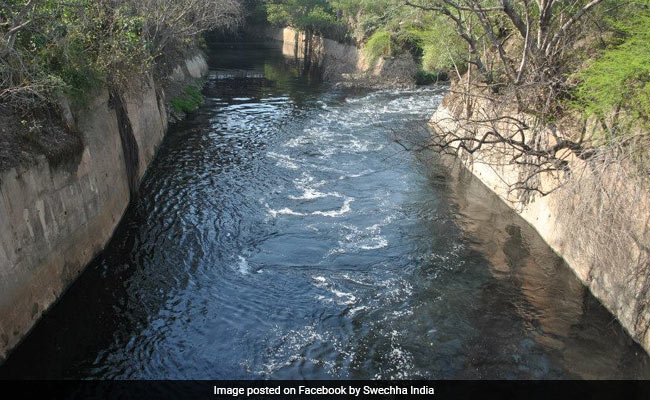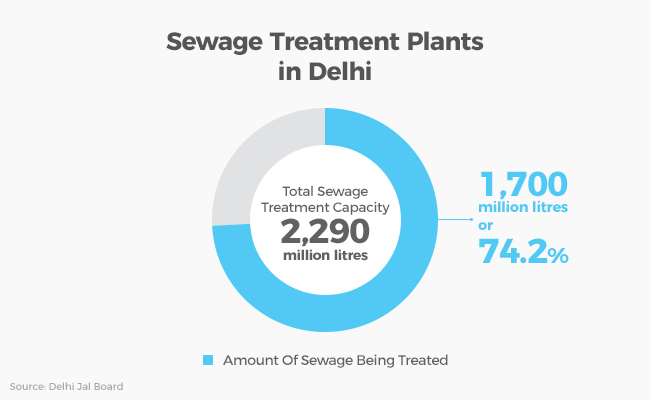Highlights
- Delhi Jal Board is building Interceptor Sewers to tackle Yamuna pollution
- These will divert sewage to treatment plants before meeting the main drains
- However, the project has currently been stalled by the NGT
New Delhi: As a pristine Yamuna meanders into Delhi through the Wazirabad barrage, 375 kilometres from the point of its origin, its waters transform into a murky, shallow toxic cocktail of sewage and garbage. And all this starts with the Najafgarh Nalla, Delhi’s largest drain, which meets the river almost immediately at the entry point of Wazirabad and dumps gallons of untreated sewage into the Yamuna every day. What makes this situation even more outrageous is that the Capital has sewage treatment plants with the capacity to treat a significant amount of this sewage and yet all the sewage enters Yamuna, untreated. The reason for this is the lack of infrastructure to channel the sewage to these plants for treatment. Looking to remedy this, the Delhi Jal Board has been constructing ‘Interceptor Sewers’ to block existing sewerage lines before they enter drains like Najafgarh and divert the sewage to treatment plants.
Read More: Why Untreated Sewage Continues To Be Dumped Into The Yamuna
Intercepting Sewage
So what exactly are ‘Interceptor Sewers’ and how will these help?
The sewerage network which presently exists in Delhi is a net of smaller sewers from different areas and neighbourhoods emptying out into larger drains. It is these major drains that then meet the Yamuna.
To treat all this sewage—nearly 3,800 million litres of it per day, according to Central Pollution Board estimates—these smaller sewers would have to be connected to sewage treatment plants. However, this would be a herculean and incredibly capital intensive task.
“Delhi has at least 1,670 unauthorised colonies whose drains directly connect with the large nallas. If we were to lay out new lines for these it would take us at least 25 to 30 years,” says RS Tyagi, Member and Engineer-in-Chief, Delhi Jal Board.
Instead, to remedy the problem at a quicker pace, the Delhi Jal Board has turned to another solution—Interceptor Sewers.
The idea behind these sewers is that rather than laying a massive network of new lines, a trunk sewer running along the large drains should be constructed. These would be able to intercept the smaller sewers and block them from meeting the main drains and channelise it to the nearest sewage treatment plant.
For example, under this programme, a trunk sewer is being laid to run parallel to the Najafgarh Drain to stop the sewers that empty into it. This sewage will then be diverted to different sewage treatment plants along its length. These would then treat the sewage and connect back with the Najafgarh Drain.
Similar projects are coming up at the Shahrdra Drain and Supplementary Drain which along with the Najfgarh Drain also happen to be the biggest carriers of untreated sewage and are collectively responsible for the largest share of pollutants that enter the Yamuna. In fact, according to the CPCB, the Najafgarh Drain contributes to a whopping 32.99 per cent of the pollutants that flow into the river in Delhi while the Shahdara Drain is responsible for 17.56 per cent.
Also read: How The Yamuna Went From One Of India’s Holiest To One Of World’s Dirtiest
Once completed, these interceptor drains could stop the flow of 245 million gallons (927 million litres approx.) of untreated sewage into the Yamuna per day.
Green Court Order
According to the Delhi Jal Board, 85 per cent of the work on these drains is already complete. However, the work is stuck since June 2016 as it has been stayed by the National Green Tribunal (NGT) under the ongoing Manoj Mishra vs. Union of India case and is being reviewed.
“Once we get a go ahead from the NGT, the project should take a year or so to complete,” says Mr Tyagi.
The next hearing on this case is scheduled for April 26, 2017.
Building Capacity
Even once the existing treatment plans start running to their optimum capacities, aided by the interceptor sewers, Delhi would still be producing more sewage than it can treat.
However, there is some good news. Delhi Jal Board is already working on constructing new plants.
“We are currently constructing a new sewage treatment plant at the Coronation Pillar which will have the capacity to treat 70 million gallons per day and one in the Delhi Cantt area which will treat 8 million gallons of sewage per day,” Mr Tyagi tells NDTV.
Additionally, the Jal Board is constructing 14 decentralised plants in Delhi’s rural pockets which will together be able to treat 50 million gallons of sewage every day.
According to the Jal Board, just implementing these projects to ensure the proper treatment of sewage could reduce pollution in the river by 60 per cent.
While all this seems ambitious, it is critical to saving the Yamuna which has often been described by experts as a dead river. And the urgency of this is something that has and is being recognised by different agencies in the country–from the Nainital High Court recognising the river as a living entity, the ongoing case in the NGT to a 23-year-old Supreme Court Public Interest Litigation which has being trying to look into the matter of rejuvenating the Yamuna. However, the river’s future remains disconcerting as, despite all of this, real progress is yet to be made.





























